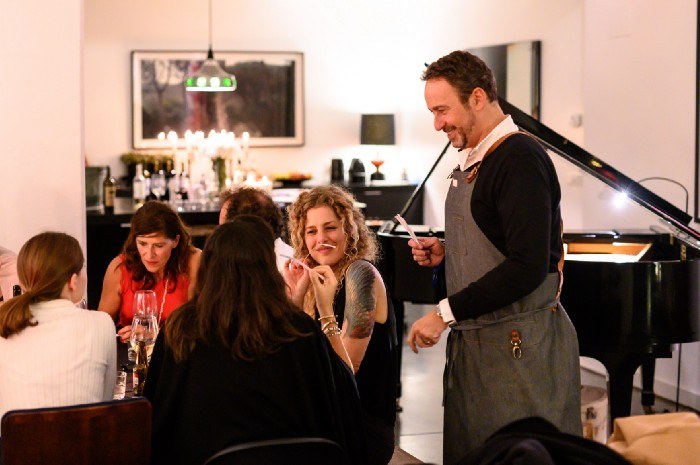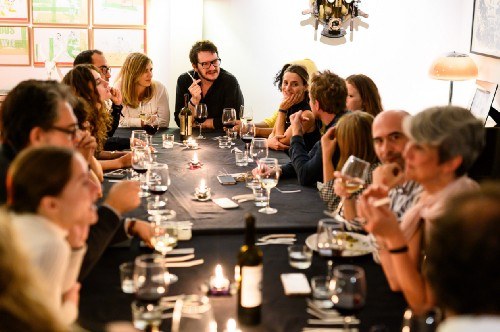A Beautiful Sense

By Sarah Souli
Off the eastern coast of India lies the azure-blue, palm tree-laden archipelago of the Andaman Islands. For the Ongee natives living there, life—both social and personal—is entirely constructed around scent. Months are marked by the fragrance of flowers that bloom at specific times, and seasons are named after particular odors.
When referring to oneself, the Ongee touch the tip of their nose, as “me” and “my smell” are indistinguishable. Odor and personal energy are intrinsically linked, too. When meeting a friend, the Ongee ask “How is your nose?” If someone feels “light with odor,” the polite response is to lightly blow some of your own odor onto them; an exhausted “heavy with odor” response requires sucking in some of their scent.
Recently, 10,000 kilometers away in Portugal, several attendees of the House of Beautiful Business were busy asking each other about their noses during a beautifully orchestrated Lisbon Dinner Festival meal at celebrated perfumer Lourenço Lucena’s private home. To say this was an unusual dinner would be an understatement, even by the sensual standards of the House.

In much of the western world, scent has been relegated to the lower-class of senses, nowhere near as important as sight or hearing. This is partly because of the ever-expanding use of technology in our daily lives. Images and sounds are easily conveyed through our phones, televisions, and computers. We want to share information quickly. What role does scent have in that? Scent remains elusive, mysterious.
It also has been hidden and banished. We spray our bodies with perfume, and put deodorant under our arms, scrubbing away our natural odor. We buy room deodorizers and install automatic scent dispersants. Cleaning crews power-hose boulevards and collect trash (thank god, one might add: in the 1800s, city stench was so overbearing that a perfume-soaked handkerchief was an essential part of any outfit). But identifying and interacting with smells, both good and bad, makes us multi-dimensional. When scent is removed, it’s like we flat line.
During our dinner, Lucena offered us paper sticks sprayed with different odors that captured the varying scents of Lisbon: musty books, gasoline, fleur d’oranger. We inhaled deeply and sighed melancholically. As we ate broiled cod and deconstructed cornbread stuffing, we shared stories of our favorite scents: Fresh snow, baking bread, grilled meat, newly cut grass, the dirt in a childhood backyard. One woman began to choke up as she talked about the smell of a lover. A picture may be worth a thousand words, a song may stir your soul, but scent has its own incredibly powerful allure.
A relatively new field of study, neuroaesthetics, is catching on to what the more sensual among us have known for a long time: beauty can have a profound impact on the brain. Neuroaesthetics aims to show us how that impacts our mental health and physical well-being. “Researchers have recently linked a declining sense of smell to higher risk of death and a potential predictor of neurodegenerative disorders like dementia and Parkinson’s disease,” writes Ed Decker for IAM Lab.
“The question of beauty is something that science has shied away from,” Nancy L. Etcoff, Assistant Clinical Professor in Psychology at Harvard Medical School told the Harvard Crimson in 2017. “It didn’t seem answerable or definable. Happiness is another one. There are a lot of books on negative emotions like disgust, fear, anger.” Etcoff, the article notes, is “interested in expanding the scope of science to the pleasures in life, like the appreciation of art and beauty, and positive emotions like happiness, calm, gratitude, awe, relief.”
At this year’s Salone de Mobile, the world’s most important design fair, Google tested the waters of neuroaesthetics with their project A Space for Being. Along with IAM Lab, Muuto, and Ready Design, Google created a series of three rooms with a specific mix of scent, sound, texture, and sights. One of the world’s most renowned natural perfumers, Mandy Aftal, was charged with imbuing each room with scents that activated visitors’ limbic system, evoking varying emotions and feelings.
Visitors wore custom-made bands that measured heart and breathing rates through a PPG sensor, skin conductivity using an EDA sensor (electrodermal activity) and skin temperature using a different sensor. The organizers were able to identify which room (and which scent) individuals responded best to. Though the field is nascent, neuroaesthetics can help us tap into one of the best things about being human: our ability to find beauty through our senses.

Back in Lisbon, we were served the final course of our dinner: homemade custard pies (pasteis de nata). These little tarts are usually served with a dusting of cinnamon, but the chef brought out a bowl of cinnamon-laced simple syrup and a bubble maker. He dipped the machine into the bowl and blew out a string of glassy, sugary bubbles. As they burst in the air, we were enveloped in the warm, toasty smell of cinnamon. We all laughed and clapped our hands, as delighted as children in front of a carnival performer.
An urgent thought formed in my brain and has been stuck there since: inhale deeply, and often.
Sarah is a freelance journalist based in Athens. Her work has been featured in The New Republic, The Economist, The Guardian, Vice, and others. She is a contributing writer to the Journal of Beautiful Business.
